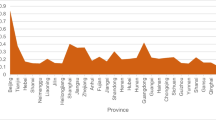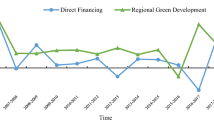Abstract
Finance has a strong role in promoting green development; however, there are very few studies quantifying this relationship. To this end, based on the official green development indicator system of the Chinese government and province-level data from 2006 to 2017, the quantile regression model was used to analyze quantitatively the impact of finance on green development. The results show that financial development contributed significantly to green development, and furthermore, financial efficiency and green finance have a strong positive effect with the increase of the quantile, and financial scale also has a significant positive effect, but a diminishing marginal effect. In addition, the impact of financial development on green development has regional differences. In the eastern region, the finance factors can promote green development, but the financial scale and the green finance promotion function weaken along with the quantile increase. The financial scale and green finance do not support green development significantly in the central region. Financial scale, efficiency, and green finance support green development in the west region.

Similar content being viewed by others
Data Availability
The data that support the findings of this study are collected based on the published data by the China National Bureau of Statistics. They are available from the corresponding author on reasonable request.
Notes
Based on statistical mathematics and fuzzy mathematics, cloud model unifies the randomness and fuzziness between uncertain linguistic value and accurate value, and realizes the natural conversion between qualitative linguistic value and quantitative value.
References
Abbasi F, Riaz K (2016) CO2 emissions and financial development in an emerging economy: an augmented VAR approach. Energy Policy 90:102–114
Zhou H, Xu G (2022) Research on the impact of green finance on China’s regional ecological development based on system GMM model Resource Policy 75. https://doi.org/10.1016/j.resourpol.2021.102454
Albrizio S, Kozluk T, Zipperer V (2018) Environmental policies and productivity growth: Evidence across industries and firms. J Environ Econ Manag 81:209–226. https://doi.org/10.1016/j.jeem.2016.06.002
Baur DG (2013) The structure and degree of dependence: a quantile regression approach. J Bank Finance 37(3):786–798
Beck R, Georgiadis G, Straub R (2014) The finance and growth nexus revisited. Econ Lett 124(3):382–385
Bekhet HA, Matar A, Yasmin T (2017) CO2 emissions, energy consumption, economic growth, and financial development in GCC countries: dynamic simultaneous equation models. Renew Sustain Energy Rev 70:117–132
Chen Q (2014) Advanced econometrics and STATA applications (second edition). China High Educ Press
Cheng Z , Liu L , Liu J (2020) Natural resource abundance, resource industry dependence and economic green growth in China Resour Policy 68. https://doi.org/10.1016/j.resourpol.2020.101734
Daly HE (2013) A further critique of growth economics. Ecol Econ 88:20–24
Danish, Ulucak R (2020) How do environmental technologies affect green growth? Evidence from BRICS economies Sci Total Environ 712 https://doi.org/10.1016/j.scitotenv.2020.136504
Eren BM, Taspinar N, Gokmenoglu KK (2019) The impact of financial development and economic growth on renewable energy consumption: empirical analysis of India. Sci Total Environ 663:189–197
Fang G, Wang Q, Tian L (2020) Green development of Yangtze River Delta in China under population-resources-environment-development-satisfaction perspective Sci Total Environ 727. https://doi.org/10.1016/j.scitotenv.2020.138710
Fan G, Zhang X (2019) Toward high-quality development in the People’s Republic of China. ADB East Asia Working Paper Series No.18
Feng C, Wang M (2019) Journey for green development transformation of China’s metal industry: a spatial econometric analysis. J Clean Prod 225:1105–1117
Feng C, Wang M, Liu G, Huang J (2017) Green development performance and its influencing factors: a global perspective. J Clean Prod 2017(144):323–333
Hu A (2017) The theory of green development. In: China: Innovative Green Development. Springer, Singapore. https://doi.org/10.1007/978-981-10-2806-9_2
Guo M, Hu Y, Yu J (2019) The role of financial development in the process of climate change: evidence from different panel models in China. Atmos Pollut Res 10(5):1375–1382
Huang M, Li S (2020) The analysis of the impact of the Belt and Road initiative on the green development of participating countries Sci Total Environ 722. https://doi.org/10.1016/j.scitotenv.2020.137869
Jiang M, Luo S, Zhou G (2020) Financial development, OFDI spillovers and upgrading of industrial structure. Technol Forecast Soc Chang 155
Li X, Du J, Long H (2019) Theoretical framework and formation mechanism of the green development system model in China. Environ Develop 32
Li Y, Chen Y, Li Q (2020) Assessment analysis of green development level based on S-type cloud model of Beijing-Tianjin-Hebei, China. Renew Sustain Energy Rev 133
Liang Q, Teng J (2006) Financial development and economic growth: evidence from China. China Econ Rev 17(4):395–411
Lin B, Benjamin NI (2017) Green development determinants in China: a non-radial quantile outlook. J Clean Prod 162:764–775
Lin B, Zhu J (2020) Policy effect of the Clean Air Action on green development in Chinese cities J Environ Manage 258. https://doi.org/10.1016/j.jenvman.2019.110036
Koenker R, G Bassett G (1978) Regression quantiles. Econometrica 46(1):33–50
Pradhan RP, Arvin MB, Bahmani S (2018) Are innovation and financial development causative factors in economic growth? Evidence from a panel Granger causality test. Technol Forecast Soc Chang 132:130–142
Qiu S, Wang Z, Liu S (2021) The policy outcomes of low-carbon city construction on urban green development: evidence from a quasi-natural experiment conducted in China. Sustain Cities Soc 66
Qu C, Shao J, Cheng Z (2020a) Can embedding in global value chain drive green growth in China’s manufacturing industry? J Clean Prod 268:121962
Qu C, Shao J, Shi Z (2020b) Does financial agglomeration promote the increase of energy efficiency in China? Energy Policy 146. https://doi.org/10.1016/j.enpol.2020b.111810
Samargandi N, Sohag K (2022) The interaction of finance and innovation for low carbon economy: evidence from Saudi Arabia EnergStrat Rev 41. https://doi.org/10.1016/j.esr.2022.100847
Shahbaz M, Shahzad SJH, Ahmad N et al (2016) Financial development and environmental quality: the way forward. Energy Policy 98:353–364
Si S, Lyu M, Lawell C, Chen S (2021) The effects of environmental policies in China on GDP, output, and profits Energy Economics 94. https://doi.org/10.1016/j.eneco.2020.105082
Sun Y , Ding W (2020) Measuring China’s regional inclusive green growth Sci Total Environ 713. https://doi.org/10.1016/j.scitotenv.2019.136367
Sun C, Tong Y, Zou W (2018) The evolution and a temporal-spatial difference analysis of green development in China. Sustain Cities Soc 41:52–61
Tamazian A, Rao B (2010) Do economic, financial and institutional developments matter for environmental degradation? Evid Transit Econ Energy Econ 32(1):137–145
Zhang H, Geng Z , Yin R, Zhang W (2020) Regional differences and convergence tendency of green development competitiveness in China J Clean Prod 254. https://doi.org/10.1016/j.jclepro.2019.119922
Tian C, Feng C (2021) The effect of resource abundance on Chinese urban green economic growth: a regional heterogeneity perspective. Growth Chang 52(3):1680–1700
Zhou G, Zhu J, Luo S (2022) The impact of fintech innovation on green growth in China: mediating effect of green finance Ecol Econ 193. https://doi.org/10.1016/j.ecolecon.2021.107308
Wang M, Zhao H, Cui J, Fan D, Lv B, Wang G, Li Z, Zhou G (2018) Evaluating green development level of nine cities within the Pearl River Delta, China. J Clean Prod 174:315–323. https://doi.org/10.1016/j.jclepro.2017.10.328
Wang M, Feng C (2021a) The win-win ability of environmental protection and economic development during China’s transition. Technol Forecast Soc Change 166 No. 120617
Wang M, Feng C (2021b) Revealing the pattern and evolution of global green development between different income groups: a global meta-frontier by-production technology approach. Environ Impact Assess Rev 89 No. 106600
Weng Q, Qin Q, Li L (2020) A comprehensive evaluation paradigm for regional green development based on “five-circle model”: a case study from Beijing-Tianjin-Hebei J Clean Prod 277. https://doi.org/10.1016/j.jclepro.2020.124076
Wu J, Lu W, Li M (2020) A DEA-based improvement of China’s green development from the perspective of resource reallocation. Sci Total Environ 717(15). https://doi.org/10.1016/j.scitotenv.2020.137106
Xie T, Liu J (2019) How does green credit affect China’s green economy growth? China Populat Resour Environ 9
Xu B, Lin B (2016) A quantile regression analysis of China’s provincial CO2 emissions: where does the difference lie? Energy Policy 98:328–342
Yang Y, Guo H, Chen L, Liu X, Gu M, Ke X (2019) Regional analysis of the green development level differences in Chinese mineral resource-based cities. Res Policy 61:261–272
Yang Y, Su X, Yao S (2021) Nexus between green finance, fintech, and high-quality economic development: empirical evidence from China Resour Policy 74. https://doi.org/10.1016/j.resourpol.2021.102445
Yuan H, Feng Y, Lee J, Liu H, Li R (2020) The spatial threshold effect and its regional boundary of financial agglomeration on green development: a case study in China J Clean Prod 244. https://doi.org/10.1016/j.jclepro.2019.118670
Yuan H, Zhang T, Feng Y, Liu Y, Ye X (2019) Does financial agglomeration promote the green development in China? A spatial spillover perspective J Clean Prod 237. https://doi.org/10.1016/j.jclepro.2019.117808
Zhang Y (2011) The impact of financial development on carbon emissions: an empirical analysis in China. Energy Policy 39(4):2197–2203
Zhang J, Wang L, Wang S (2012) Financial development and economic growth: recent evidence from China. J Comp Econ 40(3):393–412
Zhang Y, Peng H, Liu Z, Tan W (2015) Direct energy rebound effect for road passenger transport in China: a dynamic panel quantile regression approach. Energy Policy 87:303–313
Zhang H, Geng C, Wei J Coordinated development between green finance and environmental performance in China: the spatial-temporal difference and driving factors. J Clean Prod 346. https://doi.org/10.1016/j.jclepro.2022.131150
Funding
We gratefully acknowledge the following financial support: the Youth Program of National Social Science Fund of China (17CJL014), the Special Fund Program of China Postdoctoral Science Foundation (2017T100525), the Soft Science Research Project of Henan Province (212400410523), and the major project of the School of Economics in Henan University “Research on ecological civilization economy in the new era.”
Author information
Authors and Affiliations
Contributions
GX: wrote the draft of the paper. HC: built the model and ran the software. HY: part of literature review, modified and polished language. PS: supervision.
Corresponding author
Ethics declarations
Ethics approval
Not applicable, because this article does not contain any studies with human or animal subjects.
Consent to participate
Not applicable.
Consent for publication
Not applicable.
Competing interests
The authors declare no competing interests.
Additional information
Communicated by Nicholas Apergis.
Publisher's Note
Springer Nature remains neutral with regard to jurisdictional claims in published maps and institutional affiliations.
Rights and permissions
About this article
Cite this article
Xu, G., Chang, H., Yang, H. et al. The influence of finance on China’s green development: an empirical study based on quantile regression with province-level panel data. Environ Sci Pollut Res 29, 71033–71046 (2022). https://doi.org/10.1007/s11356-022-20856-0
Received:
Accepted:
Published:
Issue Date:
DOI: https://doi.org/10.1007/s11356-022-20856-0




